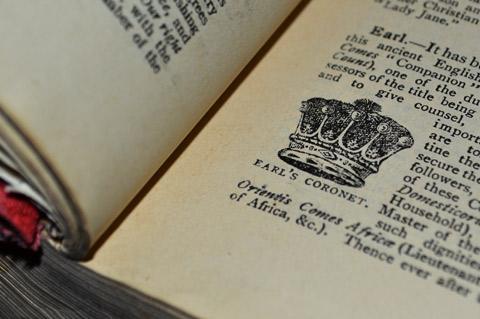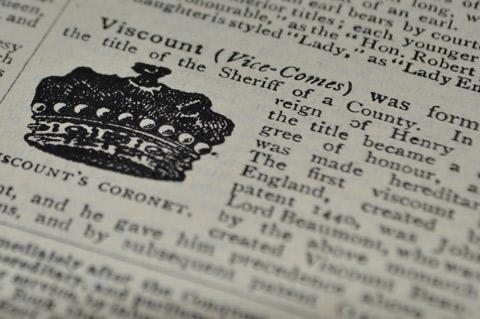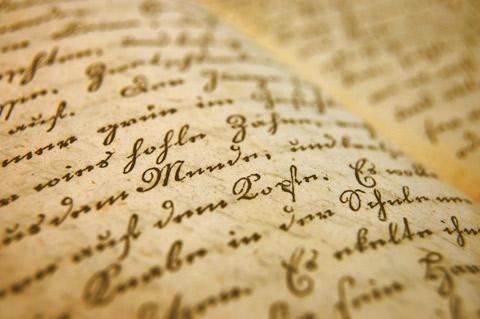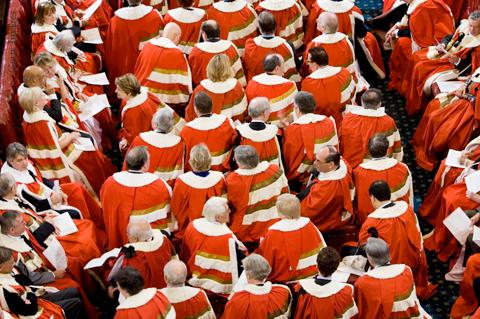
The five titles of the peerage, in descending order of precedence, or rank, are: duke, marquess, earl, viscount, baron. The highest rank of the peerage, duke, is the most exclusive.
This hierarchy of titles becomes further complicated by the fact that an individual peer can hold several peerages of different rank, created and conferred, or inherited, at different times over the centuries.
The precedence that any one peer has among those of his own degree (rank) is dependent upon the antiquity of the peerage in question. That is to say, the older the title, the more senior the title-bearer.
The Life Peerage Act of 1958 allowed the government to create life peerages (all baronies). Normally the Prime Minister chooses only peers for his own party, but he also permits the leaders of opposition parties to recommend peers from their own parties. Life peers, sometimes referred to as 'working peers', represent the various political parties and are expected to regularly attend the House of Lords. 'People's peers' are non-political appointments and recommended by the non-statutory House of Lords Appointments Commission set up in 2000.
Until 1999, one of the main privileges of the majority of the peerage was the right to sit in the House of Lords. The 1999 House of Lords Act withdrew this right of hereditary peers, as the first stage of a radical reform proposed by Tony Blair's Labour government. However, up to 92 hereditary peers have been allowed to remain in the House until the second stage of the reforms is implemented. Life peers now form the overwhelming majority of peers sitting in the House of Lords, 357 of them having been appointed by Tony Blair.

Duke is the highest of the five ranks of the peerage, standing above the ranks of marquess, earl, viscount and baron.
The title duke is derived from the Latin dux, a leader. The title originally signified Sovereign status, for example William the Conqueror was Duke of Normandy, and it was not adopted as a peerage title until 1337, when King Edward III conferred the Dukedom of Cornwall upon his eldest son, the Black Prince.
Dukedoms were created in Parliament by the fastening of a ceremonial sword to a belt or girdle (cincture). This ceremony was traditionally used until 1615, when it was replaced by the conferring of letters patent under the Great Seal (peerage patents are always created by letters patent under the Great Seal, which represents the Sovereign’s authority).
The first subject to receive a dukedom who was not a member of the royal family, nor one nearly related, was Sir William de la Pole, Marquess of Suffolk, who was created Duke of Suffolk in 1448.
A Prince of the Royal Blood is usually created a duke either shortly after coming of age or upon his marriage. Queen Elizabeth's second son, Prince Andrew, was created Duke of York upon his marriage in 1986. Similarly her grandson, Prince William of Wales, was created Duke of Cambridge upon his marriage in 2011.
Queen Elizabeth's youngest son, Prince Edward, broke with royal tradition when he chose the title of Earl of Wessex upon his marriage in 1999. Buckingham Palace announced that the Earl of Wessex would be granted the dukedom of Edinburgh when the title reverted to the Crown (upon the succession of the then Prince of Wales to the throne). This promise was kept when King Charles granted his brother the title of Duke of Edinburgh on 10 March 2023.
The other royal dukes are the late Queen Elizabeth's first cousins, the Duke of Gloucester and the Duke of Kent (both grandsons of King George V).
At present there are 24 dukes (not including royal dukes). The premier duke and earl of England is the Duke of Norfolk. His ancestor John Howard was created Duke of Norfolk in 1483, but because he inherited his dukedom through his mother, Margaret Mowbray, the duke’s precedence (ie his seniority in terms of the antiquity of his title) is dated 1397, which is when Margaret Mowbray’s father was created Duke of Norfolk.
The premier peer of Scotland is the Duke of Hamilton and Brandon (created 1643). The premier duke, marquess and earl of Ireland is the Duke of Leinster (created 1766). The most recent (non-royal) dukedom to be created is Westminster in 1874.
Since 1989 only one dukedom has become extinct, Portland (in 1990), but the Earldom of Portland continues and is currently held by Timothy Bentinck, who plays David Archer in BBC Radio 4’s drama series ‘The Archers’.

The second most senior rank in the peerage, beneath duke, is marquess. The marquess stands above the ranks of earl, viscount and baron. The dignity of a marquess is referred to as a marquessate.
Marchio was a Norman term of reference to earls or barons guarding the Welsh and Scottish Marches, or border territories. Similarly in Germany the Count (or Graf) became known as Markgraf, anglicised to Margrave.
The title was introduced to England by King Richard II, brother-in-law of the Margrave of Brandenburg, the honour being conferred upon Robert de Vere, Earl of Oxford, who became Marquess of Dublin in 1385. The title was conferred by letters patent under the Great Seal, which represents the Sovereign’s authority.
The fact that the new title of marquess was given precedence over earls caused great offence to the latter, and de Vere’s patent was revoked in 1386.
The title of marquess remained unpopular in England. John Beaufort was the eldest of the legitimated sons of John of Gaunt. When his title, Marquess of Dorset, was attainted (forfeited) and the House of Commons appealed to King Henry IV for its restoration in 1402, Beaufort begged the king not to restore this particular title ‘as the name of marquess is a strange name in this realm’.
At present there are 34 marquesses (not including courtesy marquesses). The premier marquess of England is the Marquess of Winchester (created 1551), who lives in South Africa. The premier marquess in Scotland is the Marquess of Huntly (created 1599). Since 1989 only one marquessate has become extinct, Ormonde, in 1997.

Earl is the third rank of the Peerage, standing above the ranks of viscount and baron, but below duke and marquess.
Before King Canute (c. 994-1035) an ‘ealdorman’ administered a shire or province for the king. Under Canute the Danish equivalent of earl was introduced, and under the Norman kings the title became hereditary, although the earls eventually lost some of their responsibilities as the king’s representatives in the county to the sheriff.
As with dukes, the dignity of earl was conferred by the fastening of a ceremonial sword to a belt or girdle (cincture). In time, a ceremonial cape and golden circlet (placed on the head) were added to the ceremony. In 1615, under King James I, these rites ceased. All earldoms were conferred by letters patent under the Great Seal, which represents the Sovereign’s authority.
From the reign of King Richard II (1377-99) earldoms were either life creations or hereditary with ‘remainder to heirs male’ (the inheritance of the title was restricted to direct male heirs of the original title-holder). Some Scottish earldoms may be inherited by a woman or pass through the female line.
At present there are 191 earls (not including the Earl of Wessex and courtesy earldoms), and four countesses in their own right. The premier earl of England and Ireland is the Earl of Shrewsbury and Waterford (created 1442). The premier earl on the Union Roll is the Earl of Crawford and Balcarres (created 1398).
The most recent earldom to be created is Stockton, created in 1984. Since 1989 four earldoms have become extinct, Amherst, Monsell, Sondes and Munster, and Breadalbane is dormant. A title generally falls dormant in circumstances when a peer dies and, although it is believed that there may be heirs to the title in existence, (a) their whereabouts may not be known, or (b) there is insufficient documentary evidence for an heir to prove that he is in fact the next heir of line to the late peer.

The fourth rank in the peerage, the viscount is ranked below duke, marquess and earl, but above baron.
This title had its origin in the office of the deputy or the lieutenant (vice-comes) of a count, a rank that had become hereditary in the Holy Roman Empire by the beginning of the 10th century. It was also used for the sheriff of a county.
As a rank in the British peerage it was first recorded in 1440, during the Hundred Years’ War (1337-1450). King Henry VI, crowned King of England and France, sought to consolidate the titles of the two countries, and therefore created John Lord Beaumont both Viscount Beaumont in England and Viscount Beaumont in France.
This new peerage title received precedence above all barons, but it did not become popular until the 17th century. Viscounts were always created by letters patent under the Great Seal, which represents the Sovereign’s authority.
At the present time there are 115 viscounts (not including courtesy viscounts). The premier viscount of England is Viscount Hereford (created 1550). The premier viscount of Scotland on the Roll is Viscount Falkland (created 1620), and the premier viscount of Ireland is Viscount Gormanston (created 1478).
Since 1989 eight viscountcies have become extinct: Muirsheil, Furness, Watkinson, Lambert, Leverhulme, Greenwood, Cross and Ingleby, and Barrington is dormant or extinct.

The fifth and last rank of the peerage is that of baron, which is ranked beneath duke, marquess, earl and viscount in precedence.
Baron literally meant ‘man’, being the king’s tenant in chief (i.e. a land-holding nobleman). In the 13th century the barons were summoned by the monarch, by means of a Royal writ, to attend the Counsel or Parliament. Initially the conferral of this privilege did not imply that their successors would necessarily also be summoned to subsequent Parliaments. But by the reign of King Edward III (1327-77) it had become usual for successors of the more important barons to receive writs as a matter of course, in practice creating an hereditary dignity.
The first baron to be formally created by letters patent under the Great Seal, which represents the Sovereign’s authority, was John Beauchamp de Holt, created Baron Kidderminster, by King Richard II in 1387. After about 1440 this became the normal method of creation of baronies.
In Scotland the equivalent of Barons in England are Lords of Parliament.
The rank of baron is easily the most populated in the peerage. There are currently 426 hereditary barons and lords of Parliament (not including courtesy baronies and lordships), and nine hereditary baronesses and ladies of Parliament in their own right.
The premier baron of England is Lord de Ros (created 1264), and the premier baron of Ireland is Lord Kingsale (created 1223), who lives in New Zealand. Since 1989, 24 baronies have become extinct, one (Kinnaird) is dormant or extinct, and another (Audley) is in abeyance.

A life peerage is an honour bestowed on an individual, which cannot be passed on to the recipient’s children, although they are allowed to use courtesy titles throughout their own lifetime.
The Main Honours Committee at 10 Downing Street reviews the research of eight specialist sub-committees, covering the fields of Arts and Media, Sport, Health, Education, Science and Technology, The Economy, Community (Voluntary and Local Services), and State.
When the final list of those nominated for honours, including life peerages and knighthoods, is agreed, it is submitted, through the Prime Minister, to The King. Most life peerages are announced in the New Year Honours List, the Birthday Honours List (which marks the Sovereign’s official birthday on the third Saturday in June), the Dissolution Honours List, or the Resignation Honours List.
Prior to the Life Peerages Act of 1958, the only life peers were the Lords of Appeal in Ordinary (Judges). After the Life Peerages Act of 1958, women gained the right, for the first time, to sit in the House of Lords. Since 1958, both men and women have been appointed peers and peeresses and rank as barons and baronesses for life.
Looks like you haven't made a choice yet.